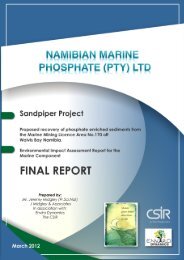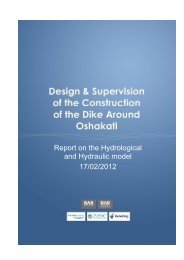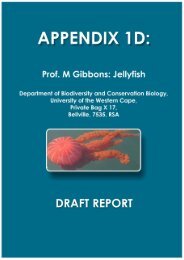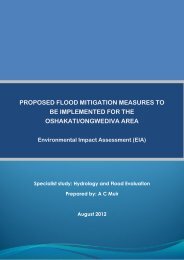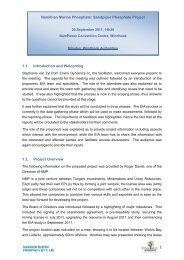Fisheries - Enviro Dynamics Namibia
Fisheries - Enviro Dynamics Namibia
Fisheries - Enviro Dynamics Namibia
Create successful ePaper yourself
Turn your PDF publications into a flip-book with our unique Google optimized e-Paper software.
F I S H E R I E S , M A M M A L S A N D S E A B I R D S S P E C I A L I S T S T U D Y<br />
Based on the survey data we conclude the following with respect to the impact of the mining<br />
on the abundance and distribution of the main commercial fish species :<br />
Hake : (Figure 27) - Hake (M. capensis) are found throughout the mining lease area. One station<br />
in the MLA and just south of SP-1 has a high frequency of occurrence of hake. Otherwise we<br />
assume the abundance of hake in the MLA and surrounding areas is fairly uniform with higher<br />
levels of hake abundance in deeper water. Mining at the specific sites is therefore expected to<br />
impact on hake but due to their mobility hake will most likely avoid the mined area. This will<br />
result in displacement of hake biomass into adjacent areas, mortality is unlikely. From an<br />
ecosystem perspective this will have implications only in a localised context (we assume hake will<br />
avoid the mined area). Disturbance of the substrate will not result in loss of food for hake since<br />
hake generally do not feed on substrate organisms and predate mostly on other fish species and<br />
squid.<br />
Horse mackerel : (Figure 28) - In the MLA horse mackerel abundance is low although high<br />
incidence of this species is expected north and westwards of the MLA. Horse mackerel are highly<br />
mobile and as with hake, are expected to be displaced outside of the mined locations. Mortality<br />
is not expected and the impact on the ecosystem is expected to be low.<br />
Monk : (Figures 29 and 30) - Monk are found throughout the MLA and the adjacent areas.<br />
Distribution appears fairly uniform. Monk are aggressive ambush predators and are found mostly<br />
on flat muddy substrate. They are also not highly mobile fish and have mostly patchy localised<br />
distribution patterns. These characteristics are expected to make monk vulnerable to mortality<br />
from the physical nature of the dredging process. This will have a localised impact on the trophic<br />
ecology but due to the relatively small area of the mining sites (up to 3 km 2 mined annually and<br />
60 km 2 in the 20 year life of mine), this impact is expected to be moderate. The removal of the<br />
preferred substrate type for monkfish will have a long-term (at least 15 years) impact on the<br />
availability of monk in and around the mining sites (starting with SP-1). Note it is not possible<br />
without long-term monitoring to determine the rate of substrate recovery (appendix 1c) or the<br />
potential for monk to repopulate the mined areas.<br />
Pelagic species : (Figure 31) - Abundance of small pelagic species is assumed to be low (based on<br />
the distribution of catch and effort only) in the MLA. Availability of this species group increases<br />
into Zone 1 and northwards into Zones 2 and 3. Due to data limitations we are unable to estimate<br />
relative abundance beyond 23°S. One survey station indicates that small pelagic species are<br />
found in the MLA. We assume therefore that small pelagic species are highly likely to be found<br />
throughout the MLA but that the impact of mining and the resulting plumes cannot be stated<br />
with sufficient confidence.<br />
Snoek : (Figure 32) - This species is found in and around the MLA. They are highly mobile and are<br />
only found seasonally and in aggregations with high abundance at these times. Snoek, when<br />
occurring in the area of the MLA and mining operation, are expected to avoid the area – i.e. will<br />
be displaced. This is not expected to have a significant impact on the ecology in the MLA and<br />
adjacent zones.<br />
Bearded goby : (Figures 33 and 34) - Two surveys suggest that gobies are distributed throughout<br />
the MLA and will occur inside the mining sites (SP1-3). Gobies have been identified as having a<br />
key trophic role in the ecosystem. As gobies are a mobile species they will be displaced. Mortality<br />
Final Report<br />
<strong>Namibia</strong>n Marine Phosphate (Pty) Ltd.<br />
Page 63



